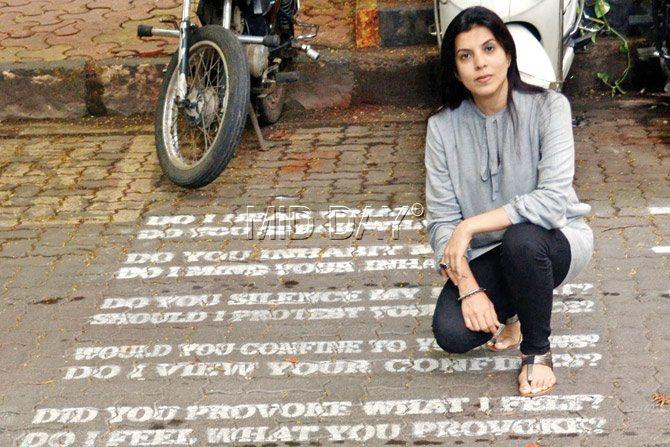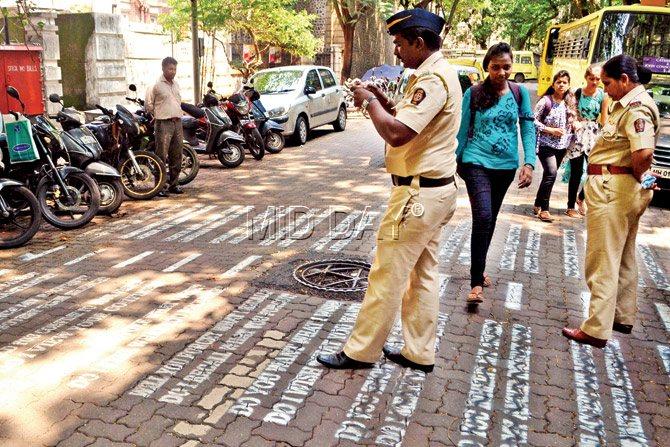Mumbai artist's public art intervention runs into rough weather with authorities

Artist Reena Saini Kallat sits beside Echoes on G Talwatkar Marg.
Ghanshyam Talwatkar Marg, a tree-lined street in Fort that sits at the junction of two of South Mumbai’s most prominent schools, The JB Petit High School for Girls and The Cathedral and John Connon School, is a fitting venue to offer food for thought to young minds.

Artist Reena Saini Kallat sits beside Echoes on G Talwatkar Marg. Pics/Datta kumbhar
ADVERTISEMENT
Prominent city-based artist Reena Saini Kallat has an ongoing exhibition titled, Hyphenated Lives on at Chemould Prescott Road gallery in Queens Mansion, a building that sits along the same street. Right outside, a zebra crossing has been painted in white. A closer look reveals words in the place of stripes. The crossing poses a series of questions to pedestrians: Do you silence my protest? Should I protest your silence? Do you see what I mean? Did I mean what you saw?

Policemen inspect the pedestrian crossing artwork on Saturday morning
These are thus conversations between two people, or with oneself, as they cross the road. “It seemed like the perfect metaphor to connect opposite ends, look at things lost in transmission and talk about the grey area between people,” she explains.
The public art intervention idea which Saini Kallat calls Echoes, was spray-painted on the tar road last Wednesday and is an extension of Hyphenated Lives, an exhibit that looks at neighbouring nations, border conflict and artificial boundaries.
The project, unfortunately, ran into rough weather on Saturday morning when Milind Bharambe, Joint Commissioner of Police (Traffic), sent members of his team to inspect the 26 ft x 14 ft work, worried that it may lead to untoward incidents arising out of confusion, with pedestrians including children, mistaking it for a regular zebra crossing. “A pedestrian crossing in the form of art is confusing for people and school children in the area. Art should be used cautiously and kept to galleries,” he said, quickly adding, “But, if art can be used to educate the public about traffic rules and regulations, that’s great.”
The artist says the fate of the work hangs in limbo for the moment, and if the traffic police chooses, it may not see the light of day on Monday. “If it looks like a zebra crossing , how is that problematic?” Saini Kallat wonders. “It is a safety measure, isn’t it? School children will only benefit.”
But Saturday’s hurdle isn’t the first problem she faced while executing the idea. Supported by Mumbai-based art agency, Asia Art Projects, Echoes came to life at 2.30 am last Wednesday. The artist had completed a quarter of the work when a sudden downpour erased the fresh paint, forcing her to halt and resume work early Thursday morning. But the bigger struggle was with acquiring permissions.
The artist reached out to the BMC, and received written permission from the A Ward officer, but Saini Kallat says the go ahead came after a nebulous discussion that brought to light the lack of rules governing an arts initiative that makes civic bodies stakeholders. She took up the suggestion to consult the RTO, but officials at the Worli headquarters were once again clueless about their role in a project
such as this.
A public arts initiative refers to a situation outside the art world that tries to alter existing conditions, whether political, social, economic or civic. But, public art, says Mumbai’s artist community, is confined to ‘beautification’ and figuring how to make an environment hospitable. Instead, it should interrupt and question urban topography, prodding the public to think about issues they may not have addressed so far.
“In the UK, for instance, if clear procedures are followed, it allows artists to display their works in public. That’s not the case here, unfortunately,” rues Saini Kallat. Those involved in the project say the officials agreed that there were rules governing how to dig roads, and mend them, how and where to put up banners, but none for “writing on the road”. However, the artist clarifies that once permission was acquired from the BMC, members of a local traffic police chowki manned the area where the artwork came up, with barricades and walkie-talkies, so that neither the prep nor traffic movement along the lane suffered. “They were cooperative. It was a small step on the part of officials, but encouraging,” she says.
While she waits for the traffic police to take a final call on the fate of her work, she says in a city where it’s hard to find an appropriate place for public art, a project’s worth must be decided by its connect with people. “Does the public want it?” she suggests we ask. “Will it enhance the space, add value? These are the things that we need to ask before we make public art.”
 Subscribe today by clicking the link and stay updated with the latest news!" Click here!
Subscribe today by clicking the link and stay updated with the latest news!" Click here!







